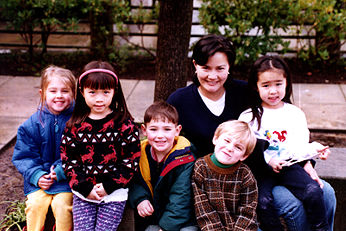Hacienda Child Development Center a Haven for Kids
Hacienda Child Development Center a Haven for Kids

"Hacienda: It's not just for grown-ups" could be a slogan at the Hacienda Child Development Center, a state-of-the-art childcare facility which offers care for infants through kindergarten-age children. With its sister organization, Hacienda Elementary School, almost 200 children spend time learning and playing in the Chabot Drive classrooms.
A HeadsUp! Center
The Hacienda Child Development Center follows the HeadsUp! Approach created by the Early Learning Institute in Palo Alto. The staff endeavors to create an enriched environment where children can grow to fulfill their potential. For instance, one goal of the center is to nurture a "heads up" child: bright, alert, motivated, independent, self-confident, and social.
The HeadsUp Approach utilizes and expands on the Montessori curriculum as well as the works of Swiss learning theorist Jean Piaget. In essence, the programs make use of play and learning games to help lay the foundation for future learning, with the preschool curriculum incorporating art, music, and imaginative play along with the traditional Montessori emphasis on practical life, experiencing the senses, language, math, science, and more.
A Critical Time
"The first four years are critical in all aspects of their development," says Joanne Mik, director of the Center. "There are many things that children learn from that time period and we really want to be able to support them."
The Center is one of few that provides infant care. "It's very expensive to provide infant care, and it's very difficult because of the staffing requirements," explains Mik. The care provided does much more than take care of the babies' basic needs, though.
"There are ways you can interact with an infant that makes it a nice experience," she says. "If you look at our center, we care about the children and we will help them to be able to grow and to achieve, to have a level of independence.
"That will affect how they interact with the children, so they talk to the babies and play games with the babies. People understand meeting their basic needs, but babies will also cry if they're bored and need stimulation. It takes someone who understands children to recognize that."
Toddlers, Too
Two year olds have a special place at the Center as well. Their daily activities include opportunities to explore and to achieve as well as something unexpected: to cook.
"They can stir things together and taste it they're very oral anyway, they put everything in their mouths so when they make something that tastes delicious, they feel wonderful about that," says Mik.
Their culinary achievements benefit the children's growth as well. "They'll sometimes want foods that you might consider unusual for a child, like olives or lemon," she says. "We find that because they have some autonomy about it, they're more interested in trying it."
Of course, attention is paid to more traditional areas of learning as well, though not necessarily in traditional ways.
"Children go through what Montessori called 'sensitive periods,' where they're more in tune with learning certain curriculum areas," she explains. "For example, a young child may be working language skills, and they'll want to know the name for everything. They really want to focus their curriculum on that, and so the teacher will allow that and provide for that, which is different from a traditional setting where you might hear, 'It's math time now.'"
Three to Six
There are unique aspects to the attention paid to the older children, as well.
For one thing, the three, four and five-year-old children are taught together.
"We have three classrooms, and all of them have kids three, four, and five years old together," says Mik. "It's great because we can keep siblings together. Plus, the kids learn from each other. It really boosts their self esteem tremendously for the older children to teach a younger child how to do something, taking that leadership position."
The children use traditional Montessori materials in math and language areas and have the opportunity to play at art, dress-up, and with toys like Legos and blocks. "At any point in the day, the children will do any of these activities," she says.
Elementary, My Dear
The Hacienda Elementary School is a continuation of the three- to six-year-old curriculum. "We know at every level what the regular curriculum is in the California schools, so we do at least that," says Mik. "Plus, we have art, foreign language, and music."
Mik adds that the Center has a very low staff turnover, noting that "parents want stability for their children and really appreciate that."
It must be true. Mik says that at this time, there is a long waiting list for admission to the Center.
For more information on either the Hacienda Child Development Center or Hacienda Elementary, call Joanne Mik at (510) 463-2885. A discount is available for Hacienda employees.
Photo: Joanne Mik, director of the Hacienda Child Development Center, surrounded by some of her happy young charges.
Also in this issue...
- ACE to Ride the Rails Starting in May
- Health Care Training Consortium Opens Annex
- Business Bits
- Executive Profile: Chris D. Kinzel, P.E.
- Hacienda Child Development Center a Haven for Kids
- Junior Achievement Gets Straight A's from Students, Volunteers Alike
- Food Bank Hosts Awards Ceremony February 26
- Chevys Fresh Mex Run Comes to Hacienda March 28
- Enjoy Local Culinary Delights at Volunteer Center's Taste of the Valley
- Hacienda Index




